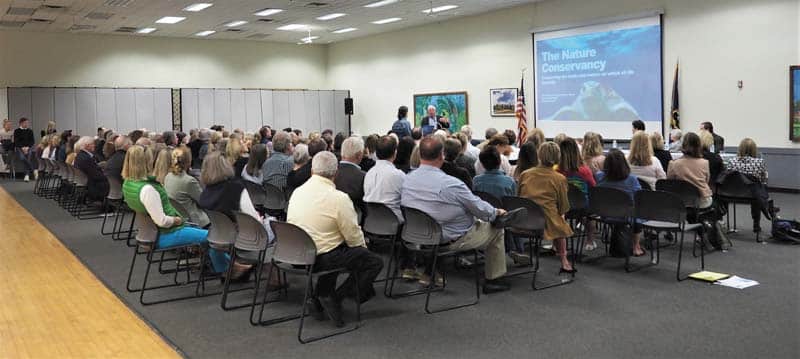What we can do to protect our water now

Attendees at The State of Long Island’s Water panel discussion, cohosted by the North Shore Land Alliance, North Country Garden Club and The Nature Conservancy, recently learned that Long Island’s water resources, both ground and surface waters, are contaminated by excess nitrogen from human septic systems, fertilizers and carcinogenic manmade chemicals such as 1,4-Dioxane.
“We treat our aquifer like a dump site,” said Sarah J. Meyland, one of the four panelists that presented that evening and a water specialist and associate professor at the New York Institute of Technology. “Fish and shellfish species are dying all over Long Island, drinking water is severely impaired, beaches are closing due to bacteria-causing toxic algal blooms, and the list goes on. Each year, the problem is getting worse.”
Nearly 150 people attended the panel discussion including State Senator James Gaughran (District 5) and State Assemblyman Steve Englebright (Assembly District 4). Experts discussed a variety of topics ranging from nitrogen loading to the condition of North Shore bays and harbors to the status of our local drinking water and the roles citizens and government can play in reducing nitrogen loading.
“Water quality is one of the most important if not the most important issue Long Island faces today,” said Lisa Ott, Land Alliance president and CEO. “Protecting land is critical to protecting Long Island’s drinking and surface waters. If we all work together, we can help reverse the problem.”
The takeaway from the evening was that Long Island faces a huge water quality problem. What can we do to fix it? The North Shore Land Alliance has utilized a number of resources and compiled a list, many being points addressed at the panel discussion, of what people can do now to help protect Long Island’s precious water resources. A simple step is having your septic system or cesspool routinely pumped to prevent clogging and overflowing, as 60 to 70 percent of the nitrogen entering our water is from septic systems or cesspools. If you are building a new home or your septic system needs to be replaced, consider new nitrogen reducing technologies.
If you’re using lawn fertilizers, use organic ones with slow-release nitrogen. Once nitrogen from fertilizers passes the root zone where plants absorb it as food, it continues to seep further into the ground until it reaches our aquifer. Up to 30 percent of nitrogen from fertilizer makes its way into our groundwater. Consider organic slow-release fertilizers like Espoma Organic Lawn Food, which may be purchased from many local garden centers.
Don’t flush over-the-counter or prescription medications down the toilet or drain. These pharmaceuticals, even in small amounts, can pollute our drinking water and negatively affect aquatic wildlife, especially fish populations. Check with your local pharmacy or police station to see whether pharmaceutical drop boxes are available.
If you choose to spray your property for ticks, mosquitoes or other insects, consider using all-natural or organic products that are safer for you and our aquifer such as garlic barrier for your lawn.
Ensuring sufficient water quantity is an important part of protecting our water source so watering your lawn every day is unnecessary. Think about installing a water gauge on your sprinkler system that waters only when the ground is dry.
—Submitted by North Shore Land Alliance


















